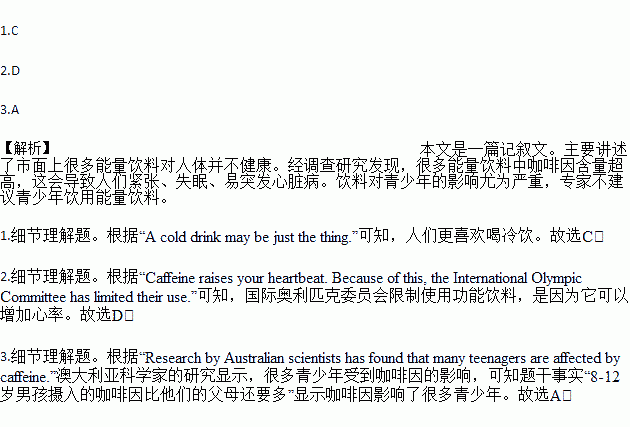题目内容
The weather is getting hotter and you’ll be getting thirstier playing basketball or riding home from school. A cold drink may be just the thing. But be careful what you pour down your throat. Something that looks cool may not be good for your health.
There are plenty of so-called energy drinks on the market. Most of them have an attractive colour and cool name. Their nutrition list also contains various things from vitamins to ginseng. Sounds great!
But after a careful check you may find that most energy drinks contain high levels of caffeine. These drinks are typically aimed at young people, students, busy people and sports players.
Makers sometimes say their drinks make you better at sports and can keep you awake. But be careful not to drink too much.
Caffeine raises your heartbeat. Because of this, the International Olympic Committee has limited their use. The amount of caffeine in most energy drinks is at least as high as in a strong cup of coffee or strong tea.
Research by Australian scientists has found that many teenagers are affected by caffeine. The results of their survey show that 27 percent of boys aged 8-12 take in more caffeine than their parents.
There are potential health risks linked to energy drinks. Just one can of energy drink can make you nervous, have difficulty sleeping and can even cause heart attacks.
Teenagers should be discouraged from consuming drinks with a lot of caffeine in them, an expert from the Australia Nutrition Foundation said.
1.Generally, people would like to .
A. take vitamins B. eat ginseng C. have a cold drink D. have a meal
2.The International Olympic Committee limit the use of caffeine because .
A. it makes you better at sports B. it can keep you awake
C. it can make you nervous D. it make your heart beat fast
3.The writer mentions the fact that “27 percent of boys aged 8-12 take in more caffeine than their parents” to show that .
A. caffeine has an effect on many teenagers
B. parents should take in more caffeine
C. the caffeine problem is not serious
D. the grownups take less caffeine than children

